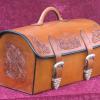-
Content Count
138 -
Joined
-
Last visited
Posts posted by TSes
-
-
Rumor has it that they may be replaced by tools from a custom maker.
-
You should always have the flat side of the beveler against the outside of the part being beveled. That way, the bevel goes away from the part (flower, leaf, stem, etc.). There are some exceptions, but this is a good general rule.
-
Really nice work. What flower center tool did you use? It goes well with your tooling style.
-
My measurements are from the tip of the buckle, to the middle hole.
-
We sell hundreds of belts every year, and 34" through 44" seem to be the most popular (in 2" increments). The biggest we've sold was a size 74.
-
Nice. It looks like you combined two tools to make your background.
-
Tandy still carries a small amount of figure carving stamps. Some of them are very small. May have to search online for used ones. The tool numbers start with the letter F. Very old ones have no letter.
-
If you're going to make sheaths for folders, you could probably make two or three sizes and have a good chance to fit several brands. But straight knives are a different story. We get a couple requests every week for straight knife sheaths, and I don't think we've ever made two the same. Too many shapes.
Buying a couple knives and using them to show your work is a good idea. But over the last couple years or so, knife prices have skyrocketed. Custom made knives are out of reach for most people. It's even hard to find a "custom" factory knife for under $100. But don't give up. There's a big market for sheaths out there.
-
I thought you heard an old song and were trying to figure out if it was Dean Martin, or Perry Como.
-
Try cutting your leather about 1/2 inch longer than needed. Then cut the fringe, leaving that extra length on the bottom uncut. That way every thing stays straight and even. When all the fringe is cut, cut off the extra length, leaving the fringe the right length. I hope I explained that clearly enough.
-
Really nice job. Especially on the carving. Your skills have improved greatly in a relatively short period of time.
-
Looks good!
-
Sounds great. I don't know how anyone can play a bass with no frets.
-
Excellent job. The face almost looks real. Great detail in the hair and beard.
-
Your carving has improved greatly in a short amount of time.
-
Beautiful work. I especially like the rich color. If I may ask, what color did you use?
-
Welcome. I hope you enjoy your leather experience. As far as your questions go... #1 (first #1) Tandy tools are a good place to start. Better tools are available, but until you get some experience, expensive tools aren't needed yet. #1 (second #1) Dividers will make a nice line to follow on wet leather for stitching. Plus they have other measuring uses. A groover will remove a small amount of leather from the surface, and allow stitching to be a little more protected. Both will make decorative lines on projects #2 No need to overstitch if you use a hammer. #3 An awl would be nice to have. I have a 4 prong and 2 prong chisel and they cover all my needs for stitching. But sometimes an awl will be needed for special projects. Even though I use chisels, I use an awl while stitching to open the holes slightly, and help line up the needle on the backside of the hole. Strap punches make life a lot easier, but cutting with a Stanley knife will work. A round knife, or head knife will work, but sometimes there's a long learning curve with those. And they could be very expensive. As you progress, they might be more attractive to you, but get some experience with the entry type tools. Good luck.
-
I think it looks very nice. Your stitching is straight and clean, even on the back side. Great job.
-
I assume that border stamp was made by one of Bob Beards' ancestors.

-
-
i assume you mean you are making a double layer for the front and the back. If that's correct, then yes you must stitch them together. You have to stitch across the top where the gun goes in, and across the bottom where the barrel goes. Then you glue the front to the back and stitch all four layers around the ends and meet the two layer stitching.
-
It looks like they did a basic whip stitch up the holster edge, then went over the top of it with the same stitch going back down the edge. Not sure on the other lace.
-
I'll be 71 in two months. Seems like I was only 51 a couple years ago.
-
The Tandy V955 looks pretty close to the veiner you need.



Block dying
in How Do I Do That?
Posted · Report reply
Not sure what you are trying to achieve, but block dying only dies the top surface of the leather, leaving the stamped or carved work un-dyed. Antiquing does just the opposite, by filling in the stamping/carving work. Block dying is done with a not too soft sponge, and a light touch so it slides across the surface. Antiquing is done with a dauber, or sheep's wool, or a soft cloth so you can work it down into the cuts. Hope this helps.